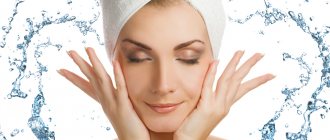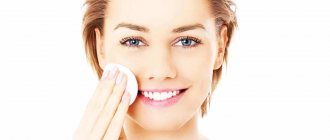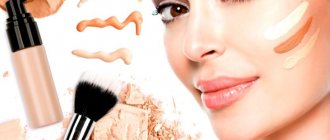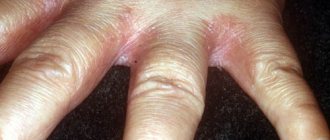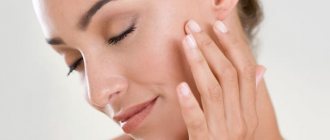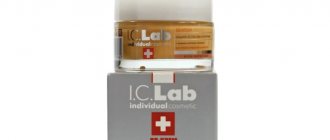Acne (blackheads) - symptoms and treatment
Acne is an inflammatory disease of the sebaceous glands and hair follicles.
Our skin has three layers:
1. top layer - epidermis;
2. middle layer - dermis;
3. underlying layer - hypodermis (subcutaneous fat).
The epidermis itself consists of several layers, the uppermost of which is called the horny layer, consists of dead corneocyte cells and performs a protective function.
The dermis is the most important layer of the skin; it is where the entire “life” of the skin is maintained. The dermis is intertwined with blood vessels and full of nerve endings. It is here that the main cells - fibroblasts - are born and work for the beauty of our skin. In addition, the dermis contains sebaceous and sweat glands, as well as hair follicles.
The hypoderma consists of loose connective tissue and fat cells - adipocytes. The thickness of subcutaneous fat depends on its location on the body and nutrition.
Of greatest interest to us are the sebaceous glands, skin appendages that are located in the dermis.
The sebaceous glands produce sebum, which is what shines so treacherously on the skin of the face, especially in the forehead, nose and chin, the so-called “T-zone”. This type of gland is hormone dependent. Sebum production occurs under careful multi-level control, which involves:
- hypothalamus;
- pituitary;
- adrenal cortex and gonads.
Hormones and their role in the development of acne
Any hormonal surge causes the sebaceous glands to actively secrete sebum.[2]
Seborrhea is a skin disease that is manifested by pathological activity of the sebaceous glands. The clinical manifestations of seborrhea are that one can observe enlarged pores, gaping or clogged with comedones, oily or dry peeling, and greasy hair. With such active production of sebum, a change in its composition occurs; laboratory studies revealed an excess amount of androgens and a reduced content of estrogens. Also, the amount of linolenic acid in sebum decreases - this helps to increase the alkaline level of the skin, disrupt barrier properties and multiply microorganisms on its surface.[3]
What microorganisms cause acne
Among the causes of acne, the first place is occupied by changes in the microbial flora of the skin. When examining the isolated microbial flora in patients with acne, a large number of anaerobic lipophilic corynebacteria, aerobic micrococci bacteria and gram-positive rods are found.
Three microorganisms take part in the inflammation process:
- corynebacterium (Propionibacterium acnes);
- cocci (Staphylococcum epidermidis);
- lipophilic fungi (Pityrosporum ovale et orbiculare).
The leading role in triggering the inflammatory process is played by Propionibacterium acnes, which produces various enzymes, including lipase. This enzyme is capable of damaging the follicle wall from the inside. The role of the immune system cannot be excluded, a decrease in the function of which is a favorable factor for the proliferation of P. acnes. A key role in the occurrence of acne is played by the hormonal status of the patient, namely hyperandrogenism - an increase in male sex hormones (testosterone and dihydrotestosterone). The sebaceous glands have certain receptors that are sensitive to androgens. Accordingly, when the level of these hormones increases, the sebaceous gland begins to pathologically actively produce sebum. In addition, the causes of acne on the face can be attributed to a hereditary factor.
Other causes of acne
All of the above etiological factors can be attributed to endogenous causes of acne , that is, having an internal nature. As for exogenous causes influencing the occurrence and development of the disease from the outside, these, first of all, include exposure to sunlight. With active insolation, skin immunity is significantly reduced, which, again, is a favorable factor for the proliferation of P. acnes.[1]
One of the reasons for the spread of acne recently is the fashion for fitness and sports, and here we cannot fail to mention bodybuilders. Due to their high-calorie diet and intake of anabolic steroids and testosterone derivatives, they are at risk for developing acne on the face, taking these drugs without consulting a doctor and taking into account the real indications for use, namely for gaining muscle mass. Taking anabolic steroids leads to sharp activity of the sebaceous glands in both men and women, even if there have been no skin problems in the past. Subsequently, various forms of acne can be observed, from acne vulgaris to conglobate forms of acne. In addition to the acquired disease, women may experience a deepening of their voice, male-pattern hair growth, and disappearance of menstruation. In men, the concentration of sperm in the seminal fluid decreases. The first point in treatment in this case will be the abolition of testosterone derivatives and anabolic steroids.[3]
Newborn acne
In the first three weeks after birth, acne occurs in 20% of newborns [7]. In infants, it appears as inflammatory papules on the cheeks and nose and closed comedones. The rash occurs due to a hormonal crisis or excessive secretion of testosterone during the prenatal period. The hormonal crisis is caused by a sharp decrease in estrol in the blood of newborns in the first weeks of life.
Acne can also appear when the mother takes systemic glucocorticosteroids in the last trimester of pregnancy.
Newborn acne goes away within a few weeks or months, so it rarely requires treatment. In this case, scars, as a rule, are not formed.
Recommendations from a dermatologist at Dawn for patients with acne
- Try to eat healthy and varied. There is no clear data on the dependence of acne on nutrition. A balanced, nutritious diet is recommended. However, it is known that foods with a high glycemic index (sweets, baked goods) increase the level of insulin-like growth factor, thereby increasing the production of sebum by the sebaceous glands.
- Don't neglect hygiene. The skin must be cleansed using gently cleansing foams or gels (soap-free products - syndets) with warm water. Do not use aggressive agents or scrubs.
- Don't squeeze acne. This can lead to increased infection and scarring. Accompany treatment with local products by moisturizing the skin. When treating acne with local agents (especially retinoids), it is necessary to increase its hydration to prevent reactions of redness and peeling (selected by the doctor at the appointment).
- Change your skin care products depending on the season. The saturation of a moisturizer with lipids and the active use of cleansers depend on the time of year. Care is affected by cold, heat, insolation, changes in humidity and other environmental factors.
- Use photoprotection while in the sun. This will reduce the formation of scars and age spots.
- Use non-comedogenic skin care products. That is, products that do not clog the ducts of the sebaceous glands.
Author:
Kuzmina Tatyana Sergeevna dermatologist, Ph.D.
Acne forms
The following forms of acne are distinguished depending on the type of morphological elements, their number, location (face, torso, scalp), presence of scars (post-acne) and cysts:
- comedonal - represented by open and closed comedones;
- papulopustular - there are inflammatory changes (papules and pustules) against the background of comedones;
- nodular - against the background of comedones, papules, pustules, there are nodes, cysts and/or scars in areas of cyst regression;
- conglobate - large nodes are formed from several communicating cysts, accompanied by a high risk of scarring.
